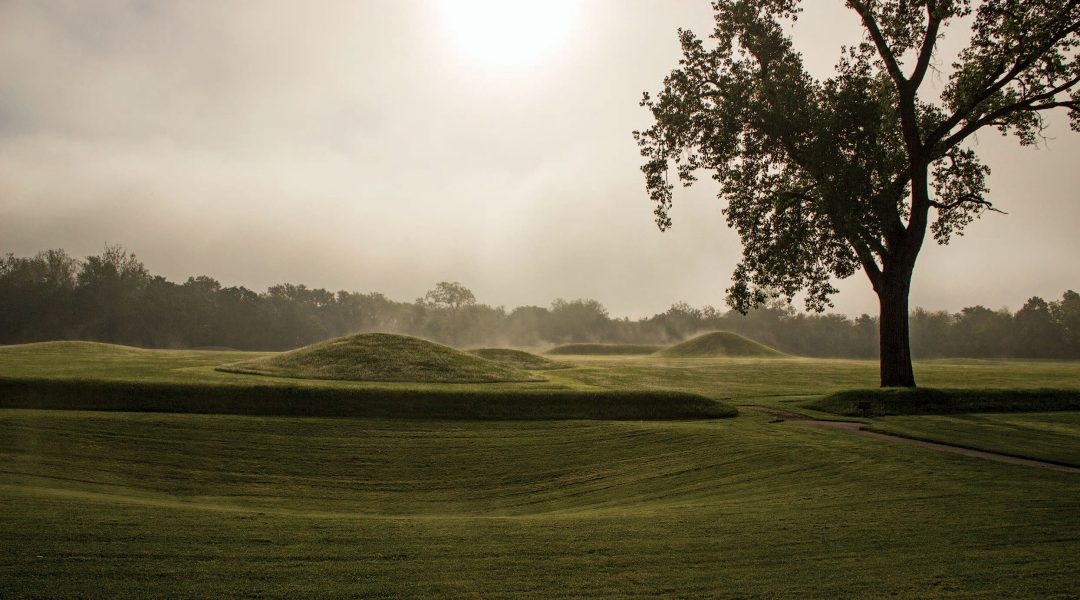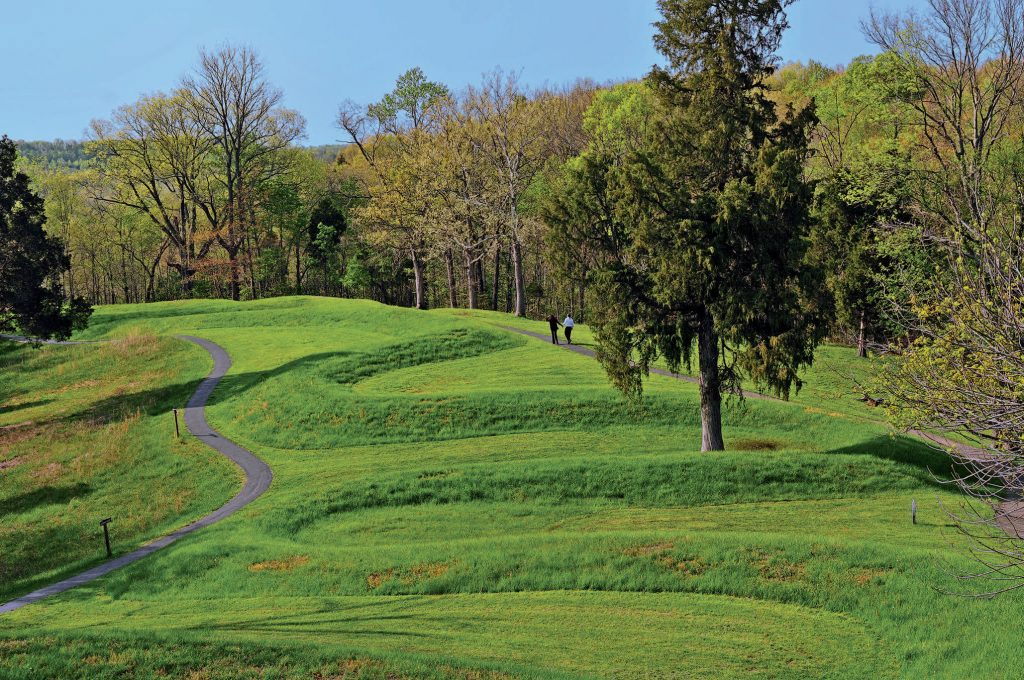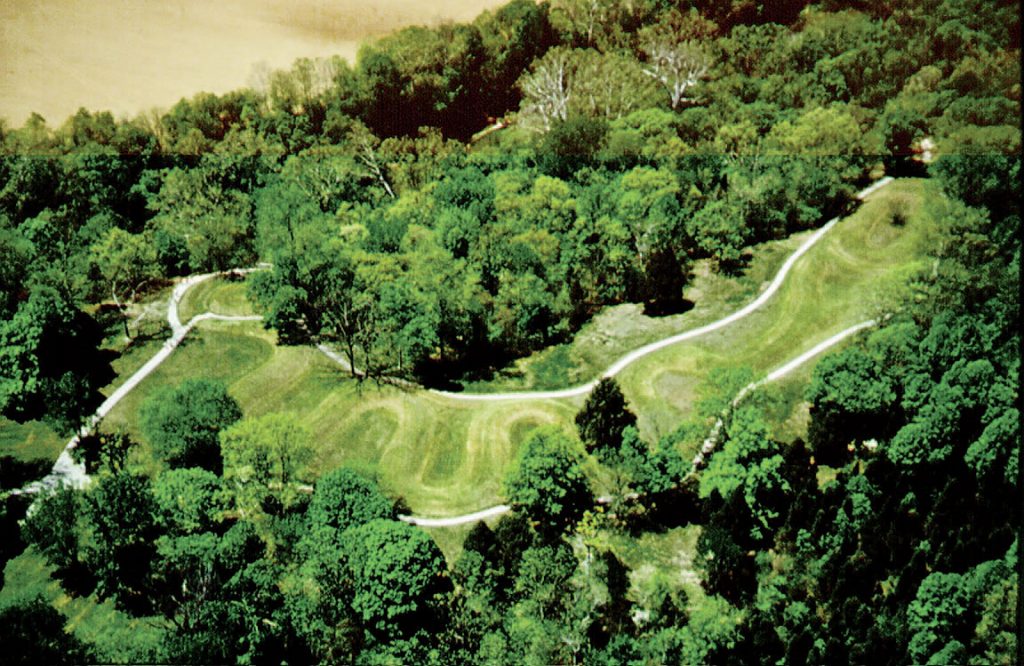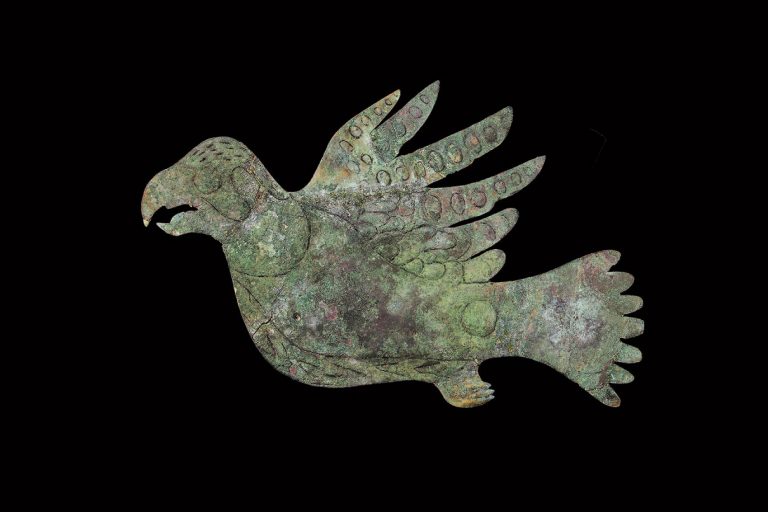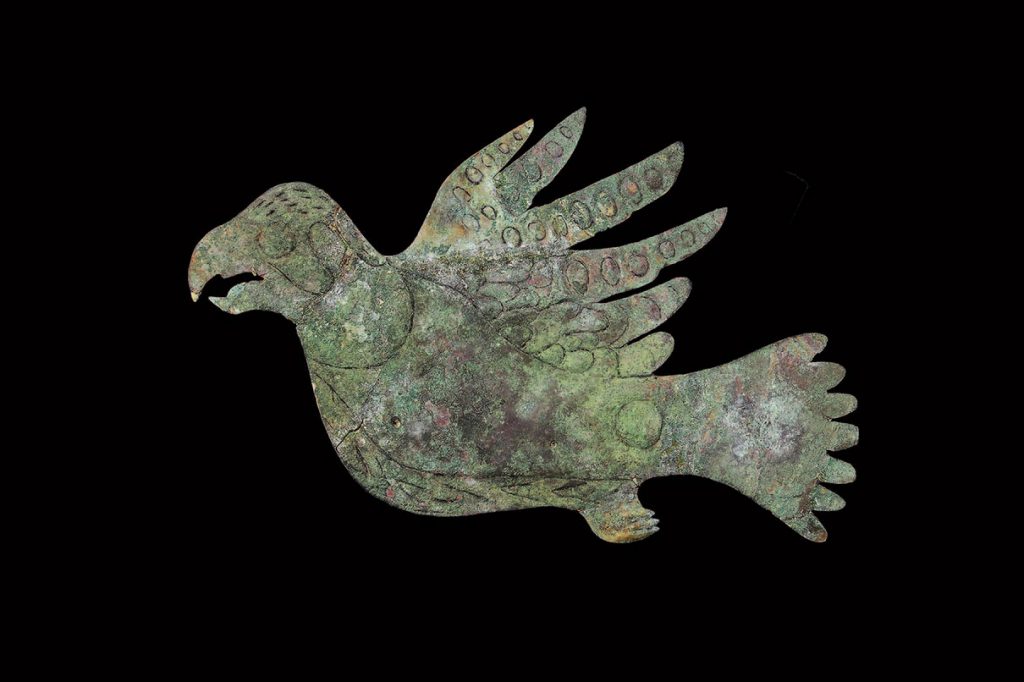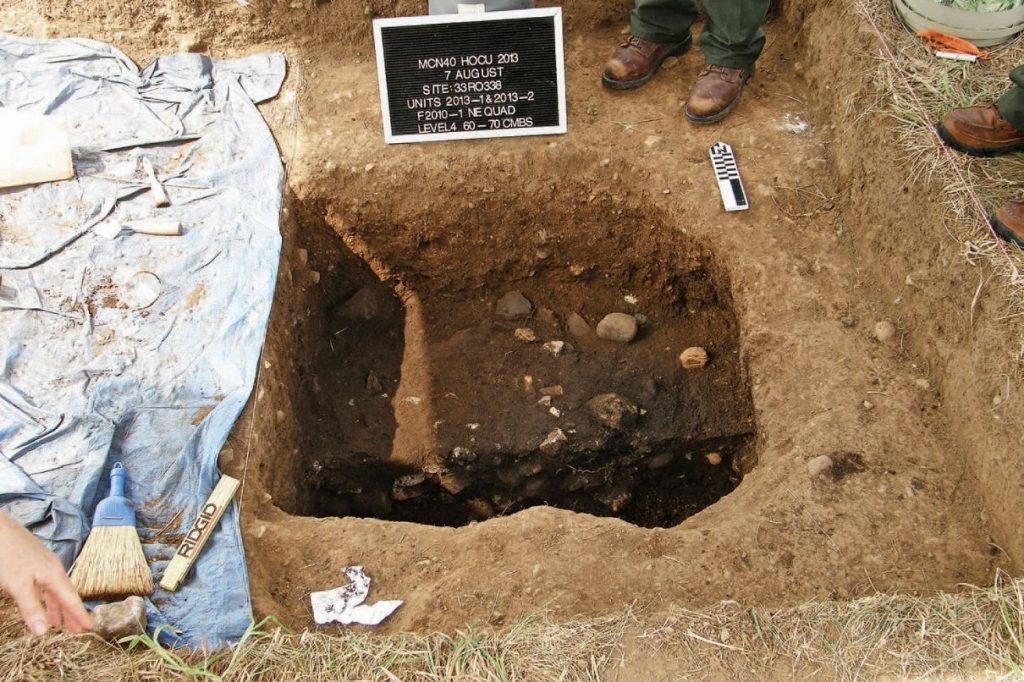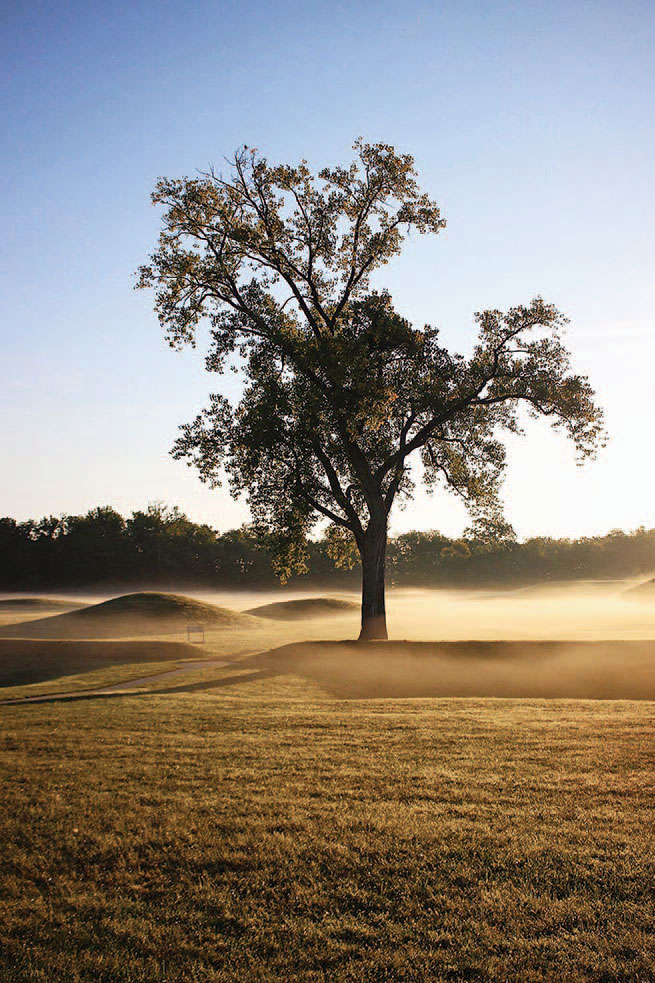A road trip reveals the mysteries of Ohio’s ancient Native earthwork sites and the father-daughter bond.
The hill climbs high in front of us. A misty rain — and the low clouds it’s coming from — covers the hill and everything else my daughter and I can see in gray. The trees that surround us on either side where we’re walking stand like stark skeletons, bleak against the sky. We hear only birds, as if the mist swallows all other sound.
Finally we arrive at the top of the hill, home to Serpent Mound, perhaps the most intriguing site among dozens of Native American earthwork locations across southern Ohio. It gets its name from the dominant feature here — an effigy mound in the shape of a snake eating what appears to be an egg. To crest the top of the hill is to enter a sacred place.
My daughter and I stop to survey the site. Ahead is the welcome center, closed. To our right is a burial mound, so small we almost miss it. The serpent is to our left. We approach the tail first. It spins a few circles, as if to gain momentum, then curves back and forth, making a shape like an M with an extra hump. We walk alongside it on a paved trail, the serpent to our left, the hill sloping down to a forest to our right.
We say little. What is there to talk about in such a place except the mystery of what the serpent is and what it’s doing here? We can’t solve it, and we don’t try. Our silence reflects the wonder and curiosity that has washed over us, a feeling that Nancy Stranahan, a natural historian and director of the Arc of Appalachia Preserve System, which manages Serpent Mound and manages and/or owns other earthwork sites in the region, still feels after years of visiting here.
Whatever this place is, whatever the snake represents, we know, instinctively, it demands reverence, even if as Stranahan puts it, “I don’t know what to be reverent about.”
My daughter and I walk toward an overlook. The sound of highway traffic reaches us and snaps me out of my reverie. At first, this noise annoys me. I was enjoying communing with this place. If I observe it silently enough for long enough maybe it will reveal its secrets to me. But now I think of the highway noise as connective tissue spanning history and cultures.
My daughter and I have come to Serpent Mound on a road trip. And while Native Americans who stood atop this hill hundreds and even thousands of years ago would not have heard the hum of rubber on pavement or the growl of internal combustion engines, they certainly would have known that others were coming and going from here. Not only did Serpent Mound draw travelers from across the region, but other ancient mound sites nearby attracted pilgrims from across the continent.
Views of the Serpent Mound in Southwestern Ohio. (Photography: Courtesy Ohio History Connection)
Road-tripping, the most American of vacations, allows freedom, the most American of values. With cars we can come and go as we please. At the very least, travel is easier when there’s no pressure to make flights or stress because of change or cancellation fees. In the age of COVID-19, we need the flexibility car travel offers more than ever, as states, cities, hotels, museums, etc. open and close.
Sometimes, like with this trip, flexibility pushes the bounds of my patience. For reasons I won’t bore you with, I had to change my destination, my accommodations (three times), the people who would go with me (also three times), and the dates (lost count).
As frustrating as all that was, the beauty of the open road is that it’s there when you’re ready. When I finally climb behind the wheel of the 2021 Yukon AT4 that GMC gave me for the week, my 14-year-old daughter rides shotgun. Pro tip: If your 14-year-old daughter asks to road trip with you, you say yes.
Normally when my wife and I take our two kids on family road trips, we rent midsize cars and preemptively winnow our packing list because otherwise we’d cram a zillion things into the trunk and backseat and forget to leave room for people. Knowing this, my 14-year-old pulls out her charmingest, doe-eyest look and tries to sweet-talk me into letting her bring extra pillows. “There are no space issues, Honey. Bring whatever you want,” I say.
The last time I road-tripped like this, I drove a Chevy Bolt EV. I could have put that in the Yukon’s glove compartment and still had room for the manual. Kidding about that, but not this: The Yukon is so big I have to rearrange my garage to fit it in.
I’m normally a bare-bones car guy. I don’t care about or use a DVD player or Wi-Fi or whatever. But the navigation system on the Yukon works where my phone’s GPS does not. That will prove helpful all week. In visiting mound sites and nature preserves, coffee shops and Dairy Bars, we drive for hours and put hundreds of miles on country mountain roads in areas with no cell service.
Automotive nerds will appreciate — as I have come to — the Yukon’s multicolor head-up display. It projects key information (my speed, speed limit, distance to next turn, etc.) onto the corner of the windshield so I don’t have to take my eyes off the road, which proves especially valuable in the mountains at night. The steep inclines and sharp turns I’m negotiating in the Ohio River Valley are easier to handle with the rig’s air-ride adaptive system, which adjusts the suspension to the conditions. Flexibility, indeed.
The time-warping contrast of the tricked-out vehicle I’m piloting and the ancient mounds I’m visiting keeps striking me. The mysterious mound builders who left evidence all over the Ohio River Valley of their sophisticated civilizations would have no idea what to make of me and my high-tech world; I have no frame of reference to make sense of them and their lives either.
When Serpent Mound was excavated in the late 1800s, it yielded no answer as to its age or who constructed it. There are three burial mounds on-site, two by the Adena people (800 B.C. – A.D. 100) and one by the Fort Ancients (A.D. 1000 – 1650). There is also evidence that people from both cultures lived atop the hill (albeit to different degrees). Since that initial excavation, evidence has been discovered suggesting each of those cultures as the source of the mound. Archaeologists have debated, without coming to a resolution, which one is correct.
Brad Lepper, senior curator of archaeology and manager of archaeology and natural history at the Ohio History Connection (which owns the site), makes a convincing case in favor of the Fort Ancients, but he won’t call his arguments definitive. He says the snake might be a retelling of an oral tradition known as the Dhegiha Siouan creation story, which is depicted in Picture Cave in Missouri. That scene is strikingly similar to Serpent Mound and is from the same time frame as the Fort Ancients.
In the story Picture Cave tells, the First Woman, also known as Old Woman Who Never Dies, has intercourse with a snake known as the Great Serpent, Lord of the Beneath World and derives the power to create humanity from the snake. Lepper suggests Serpent Mound tells the same story.
The serpent stretches 1,348 feet across the top of the hill. Covered in grass, it’s well cared for. We arrive at the head, which has a wide-open mouth eating an egg. Lepper says the egg is a reconstruction and might be a misinterpretation by an archaeologist in the 1880s. On the other side of the egg, the hill drops off to the creek below.
This overlook suggests an answer to one question: Why here? Even on a rainy winter day, an ethereal beauty radiates across the property. Humans have lived in this area many centuries. Then, as now, the ground is fertile, the weather is mild, the water is abundant, and the animals are plentiful. “If you had skill, this was Eden,” Stranahan says. “So, it’s not a big mystery that they picked a nice flat hilltop surrounded by Brush Creek. If it was for communication to spirits, what a nice place to put it.”
That’s true of many of the mound sites in Ohio, particularly Fort Hill Earthworks & Nature Preserve. Popular with birders and hikers, the preserve covers 1,300 acres 12 miles north of Serpent Mound.
The trail to Fort Hill climbs 493 feet through a rocky mature forest. A light snow falls as my daughter and I dig our boots into the hard ground. We huff and puff as we follow a 2.8-mile loop trail.
Built by the Hopewell culture 2,000 years ago, this mound is a hilltop enclosure shaped like a triangle. The mound runs 8,619 feet — or more than a mile and a half. Compared with a snake slithering across a lawn, the Fort Hill earthwork is subtle. Trees grow out of it. Looking through a thick forest, I had to study it to make sure it was a mound and not just the natural contour of the hill. It varies from 6 feet to 15 feet high, averages 30 feet in width, and encloses 35.3 acres.
LEFT: A copper cutout of a stylized bird, made by the people of the Hopewell Culture over 2,000 years ago. This copper effigy was recovered from the grounds of the Mound City Group during the 1920s excavations by Archeologist William Mills. (Photography: Courtesy National Park Service Photo/Tom Enberg) RIGHT: Excavation at the Hopewell Culture National Historical Park circa 2013. (Photography: Courtesy National Park Service)
The name Fort Hill is a misnomer: It wasn’t a fort. It was probably a ceremonial gathering site, though what kind of ceremonies took place here is unclear.
Built into the wall are 33 gates — entrances and exits to get into and out of the enclosure. Following a trail through those entrances and exits, my daughter and I enter and leave the enclosure.
We seem to be miles from the next human. The isolation transports me in time. I feel alone, disconnected from the rest of the world, like an island far out in the ocean with no way to communicate with the outside world. Or desire to, for that matter. I’m content looking at those entrances and wondering what they gave access to.
My daughter and I arrive at Hopewell Culture National Historical Park in Chillicothe, Ohio, 41 miles northeast of Serpent Mound, on a brisk afternoon. The reverence that swallowed us at Serpent Mound and the isolation that narrowed my attention at Fort Hill are lacking here. With a prison across the street and a subdivision behind the park, it’s hard to lose yourself here. But just as traffic noise was appropriate at Serpent Mound, so too are hustle and bustle here.
In and around Chillicothe, there are more ancient mounds and earthworks than anywhere else in the world. This place must have been busy when the Hopewellians built it 2,000 years ago, so it’s hard to be upset if it’s busy now.
Hopewell Culture National Historical Park comprises six sites. Mound City Group, which we tour, has at least 23 mounds in 13 acres contained within a rectangular enclosure. Two other ancient mounds stand outside the enclosure. Many other separate mound sites are close by. Sixty miles north from Chillicothe is Newark Earthworks, the largest set of geometric earthen enclosures in the world.
Dr. John Low — a citizen of the Pokagon Band of Potawatomi, associate professor in Ohio State’s Department of Comparative Studies, and the director of the Newark Earthworks Center — says it’s important to note that the mounds were built by persuasion, not force. The fact that they were made of dirt, and not stone or any other material, reflects how important they were. “Earth is the most sacred material,” Low says. “We could have used rock if we wanted to. But we used the most sacred material available to us.”
When archaeologists examined mounds in Chillicothe and Newark, they discovered copper mined from Lake Superior, 600 miles north. There was obsidian from Yellowstone, 1,700 miles west. There were grizzly bear teeth from the Rockies, 1,400 miles west. There were shells from the Gulf of Mexico, 800 miles south.
It’s important to note that the mounds were built by persuasion, not force. The fact that they were made of dirt, and not stone or any other material, reflects how important they were. - Dr. John Low
In that era, Ohio produced Flint Ridge flint. If trade with other Native American cultures brought copper from Lake Superior, obsidian from Yellowstone, etc., historians expect those areas would have Flint Ridge flint. But the amount of Ohio material found in those locations has been minimal, according to Lepper. If trade didn’t bring those goods to the Hopewells, what did? Why is there so much stuff in Ohio?
Lone tree in the fog, Hopewell Culture National Historic Park, 2015. (Photography: Courtesy National Park Service)
“This is like standing in Jerusalem and saying, Why Jerusalem?” Lepper says. “But in this case you don’t have the Bible. Or standing in Mecca and you don’t have the Koran. I think something special happened here. There was some person — a Moses, a Muhammad, a Buddha — who had some special message that resonated with people for thousands of miles. Without having those things recorded, you can’t say what that message was. Somebody fired the imaginations of people to do these great things. We don’t know his or her name.”
Low says it’s likely that person was the same one who persuaded Hopewellians to build the mounds in the first place. “It could have been a great orator or prophet or storyteller. It might have been more than just one,” he says. “It may have been several generations. It might have been a group — think the Beatles or the Stones, and how they shook the world.”
Even now, the power of that person still stretches across the centuries. As my daughter and I drive home, I think of little else but those ancient mounds, who built them and why. Whatever the person’s name, Lepper and others are working to secure their place in history. The Hopewellian sites and Serpent Mound have both been nominated to become World Heritage Sites, which would put them on the same level as some of the most famous destinations in the world.
“We’re saying these sites aren’t just important for Ohio,” Lepper says. “They’re not just important for the United States. The Native American achievements here are no less important than the Great Pyramids of Egypt, Stonehenge, the Great Wall of China. That’s how important we think these sites should be treated.”
The Hopewellian sites and Serpent Mound have both been nominated to become World Heritage Sites, which would put them on the same level as some of the most famous destinations in the world.
I don’t know how much the importance of what we’ve seen together resonates with my daughter. As we drive the hours south from Ohio toward home, we mostly ride in silence. It’s a pleasant silence. She plays on her phone some, looking up from it to talk every now and then. There are no daddy-daughter epiphany moments, but I know from experience that trying to create those doesn’t work. Our “moment” was not having a moment, if that makes sense. Instead, this is a mile down the road of life on a journey that never really ends.
As the miles rack up on the Yukon and we get closer to home, the ancients begin to recede a little into the gray mist. But I won’t forget them or this trip, and I hope my daughter will remember it fondly. I think she will. I know I will.
For more information about Ohio’s ancient earthworks, visit ohiohistory.org.
Photography: (Cover image) Courtesy National Park Service Photo/Tom Engberg
From our May/June 2021 issue






